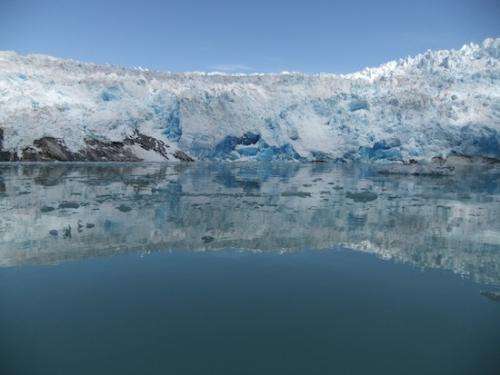Warming 'seesaw' turns extra sunlight into global greenhouse

(Phys.org)—Earth's most recent shift to a warm climate began with intense summer sun in the Northern Hemisphere, the first pressure on a seesaw that tossed powerful forces between the planet's poles until greenhouse gases accelerated temperature change on a global scale.
Climate scientists
, led by a group from the University of Wisconsin-Madison, used computer models to provide the strongest support yet to a case made nearly 90 years ago by mathematician Milutin Milankovitch. "Milankovitch actually calculated the changes in insolation—the amount of heat coming into the
Milankovitch's work showed glacial rise and decline tied to cycles of summer sun—as opposed to winter conditions, which were intuitively expected to hold sway. A glacier that could survive summer without substantial ice loss was well set to grow even during sunny winters.
The importance of summer sun has been confirmed repeatedly by studies of physical climate records, largely ice and sediment cores taken from glaciers and the bottom of oceans around the world. But the progression of warming—from north to south, or south to north—during the last great glacial melt about 20,000 years ago is hard to follow, and has proven a bone of contention among those studying ancient climate.
Using a version of the computer model of the Earth's climate used by the United Nations Intergovernmental Panel on Climate Change, He and collaborators have reproduced that global warming environment as a series of falling dominoes at opposite ends of the Earth.
"That insolation in the north is the trigger," says He, whose work will be published tomorrow (Feb. 7, 2013) in the journal Nature. "But the first consistent warming comes in the Southern Hemisphere, and that warming releases carbon dioxide into the atmosphere. The CO2 is the feedback that accelerates the warming and gets the whole world into full deglaciation."
The intersection of a pair of cyclical quirks in the Earth's orbit—one that brings it closest to the sun every 21,000 years, and another that tilts its poles closest to the sun every 41,000 years—made for particularly powerful sunshine on an icy Northern hemisphere.
The researchers added Northern Hemisphere glacial melt to the IPCC computer model and ran it through the period of the last major glacial melt repeatedly on supercomputers at the Department of Energy's Oak Ridge National Laboratory.
Model runs revealed the overturning current as key to what the researchers, whose work was funded by the National Science Foundation, called a bipolar seesaw.
Increasing sunlight alone wasn't enough to melt the northern glaciers, but enough freshwater runoff spilled into the ocean to disrupt the progression of the overturning current, which carries warm water from the southern Atlantic Ocean and returns cooler water south. Without a way to ship heat north, the Southern Hemisphere began to warm.
"When the melt water enters the ocean, it triggers the Southern Hemisphere warming, the retreat of southern sea ice, and maybe the warming of the deep ocean and circulation changes," He says. "All of this extracts CO2 from the southern oceans, and it's that change that leads to a global greenhouse atmosphere and a speeding-up of the warming process around the world."
That global temperature shift pushed even the Northern Hemisphere's glaciers into decline, and the planet into the moderate climate it enjoys today.
"This is the first study to show this mechanism reproduced to account for early deglacial warming of the Southern Hemisphere, He says. "Before, people were using this mechanism for abrupt climate change events, but we are showing this mechanism accounts for slower, lasting warming as well."
Journal information: Nature
Provided by University of Wisconsin-Madison



















